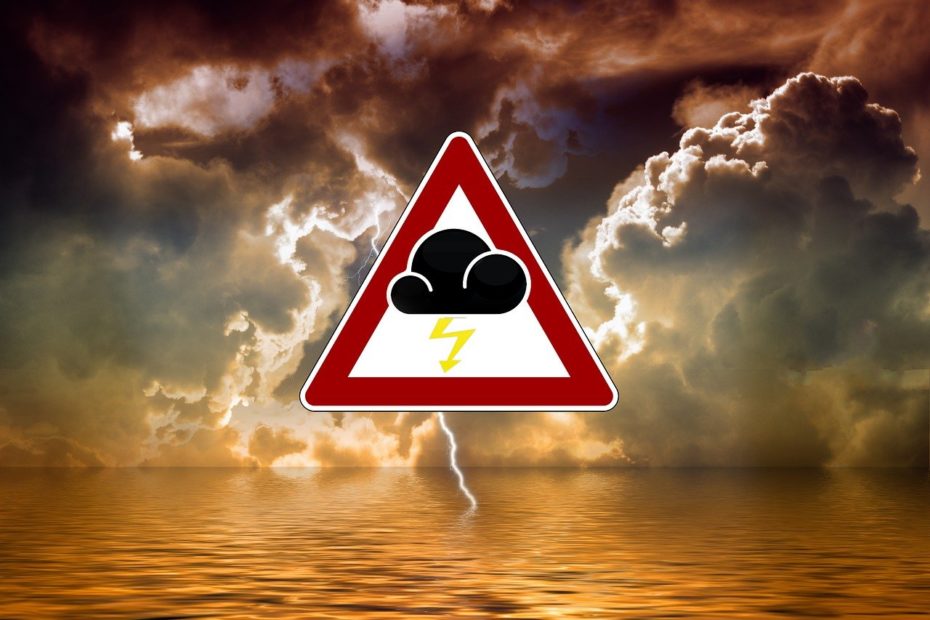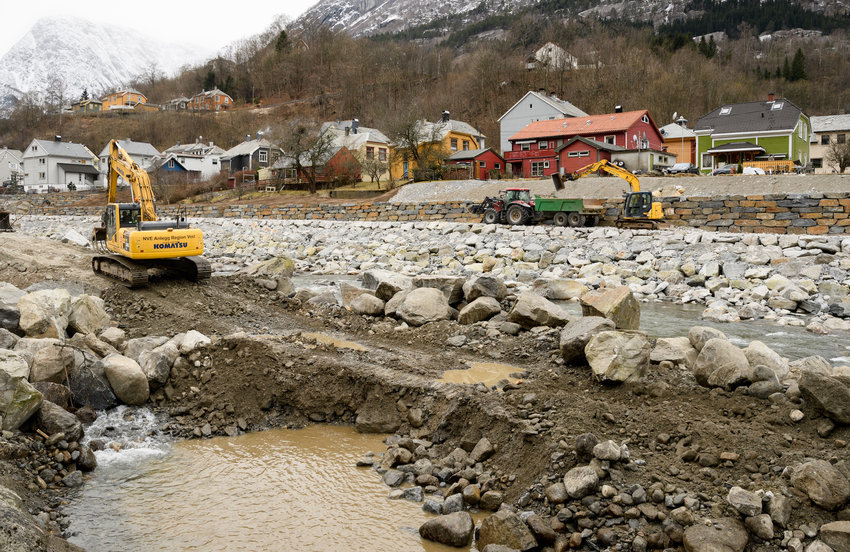
By: Kristine Skarsvåg
This article was originally written for the CONFER project, a multinational project to strengthen the resilience to climate induced effects, and risk management in East Africa. The project is coordinated by NORCE, and similarly to Climate Futures, they focus on water, energy and food security. Communication between users and researchers is important in both projects.
CONFER is working to both improve and develop new climate services for the East African region. One of the places where we can get our expertise is through the weather service YR, developed in collaboration between NRK (the national broadcasting service) and the Norwegian Meteorological Institute (MET Norway). With NRK´s expertise in reaching a broad audience and MET Norway´s meteorological expertise, there was good potential for creating a weather service that was highly functional and user friendly. The service has existed since 2007 and has been revised and improved many times since, so it is safe to say that YR has a lot of experience in developing weather services. We have talked to Dr Anders Doksæter Sivle at MET Norway about his experiences with YR and understandability and asked him to share his thoughts on how those experiences can be transferrable to CONFER.
Experiences from YR
One of the key factors to YR´s success, according to Sivle, is its focus on user insight and testing. They receive several hundred emails every month from users who have input about the service. Some users might report that the temperature forecast in one place is too high while others request more detailed additions to the service that can be useful for people with specific interests. Then there are those who are having trouble using the service and finding the information they need, and all user feedback is summarised at YR every month to figure out how to improve and continuously develop the service.
The development of YR is also driven by advances in research and technology, such as new data from ensamble prediction systems or novel observations. For example, in 2018, YR started to use private weather observations (e.g. from the smart home company Netatmo) to improve the accuracy of weather forecasts and to better meet to end-users’ needs.
Another thing that YR has focused on is what type of language is used in the forecast. In 2019, Sivle co-wrote a paper on how to adapt forecasting language to end-users. The paper discussed the use of “fair weather” and similar terms in forecasts. The previous summer had been sensationally dry and warm, and for farmers, this was not good news. Thus, the Norwegian meteorologists discovered that a more neutral tone, using terms like “sunny” and “dry weather”, might be more appropriate. This was further supported when they looked at established practices at MET offices in other countries.
Furthermore, the language used in forecasting is also closely related to how users understand the forecast. As Sivle points out, moving from Bergen (a very rainy city) to Oslo forced him to change how he presented precipitation as a meteorologist. 10 mm rain in Bergen might be referred to as “not too much rain”, while in Oslo they see 10 mm as a fairly rainy day. Local differences are important to keep in mind when presenting a forecast. Some people might not have an idea of what 10mm of precipitation actually entails, and the meaning can also differ with personal experiences and where you live. Thus, rather than providing the numbers alone, it can be valuable in some situations to explain the implications of the forecast and try to give some advice on how to use the information.
Transferring experiences from YR to CONFER
So how can these experiences be transferred to CONFER? The main goal for CONFER is to create seasonal forecasts, whereas YR is mainly focused on daily forecasts over 10 days. Nevertheless, experiences from YR can be useful to get some idea of what kind of challenges we might face when creating and improving climate services. As Sivle points out, social and cultural factors can also be important to keep in mind when creating climate services. To know how users will respond to the services, one needs to have broad cultural knowledge about the area in which the services will be used.
This can give us knowledge about what kind of information gives the highest truth value. For a meteorologist, maps and graphs might be considered to have high truth value, while for others, pictures or illustrations of how the weather will affect their neighbourhood can be perceived as more trustworthy. Furthermore, some cultures might use other means of (weather) communication, like for instance song or dance. In addition, there might be cultural differences in who is seen as a credible information source, e.g. governmental agencies, private companies, extension workers etc.
Needless to say, the obstacles encountered in the East African region will differ from the ones found in Norway. For one, the amount of people who can read is a lot less, so accessibility in this region not only refers to the fact that the service is free and publicly available but also that the forecast is understandable to anyone. This means that we need to use other means of communication than text alone. YR has received good feedback on their graphics and illustrations and are generally good at communicating the forecast in a multimodal way. Multimodality is good both because people have different preferences, but also because different forms of representation is good for solving different tasks. This will also be important for CONFER to keep in mind when designing new climate services and improving the already existing ones.
All these different factors indicate that even though we might try to create a service that is easy to use and valuable for everyone, that is not always an easy task. An alternative solution might be to create several services for different types of users, or in the case of CONFER, different sectors. Water, energy and agriculture might need different and more specified information than disaster management workers. This can be a very labour-intensive and time-consuming task, but it is something that can be worth considering when creating climate services. Nevertheless, one of the strengths of YR is that it is made so simple, but that does not necessarily stop people with more specified knowledge to use it. The simplest and most used information is on the entry page, while more specialized and detailed information can be found if you dig into the different layers of the website.
From short-term forecasts to seasonal forecasting
The most important thing to remember when transferring knowledge from short-term to seasonal forecasting is that while short-term weather forecasts tell you the weather of each day, sometimes even each hour, seasonal forecasts are periodical and based on statistics. This means that they will not be able to tell you how much rain there will be on June 7, but rather that June overall will be wetter or warmer than normal. A normal that is calculated based on years of previous data and statistics. This is basically what separates climate services from weather services, and that is important to keep in mind when we use experiences from weather services to create, evaluate, and improve climate services.
People are generally used to checking the day-to-day forecast when they are making plans or walking out the door wondering if they need their umbrella. However, interpreting a forecast and the associated uncertainty for the next month, let alone making use of it, is not something most people are used to. Just like “fair weather” can mean different things to different people, the term “normal” can as well. Thus, when climate scientists predict July to be “warmer than normal”, and add on a statistical percentage of that happening on top of it, people can get confused. Moreover, the “normal” is changing relatively fast, making it even more demanding for people to relate “normal” to their personal experiences and pre-knowledge. The scientists, however, probably have a good idea of what “normal” is supposed to mean, and they must communicate this clearly so people are able to follow the forecast. This goes for any term that is used in a certain way in the scientific community but might be interpreted differently by the reader.
“In general, the interpretation of a message cannot be defined by the sender – the information is interpreted by the receiver”
– Sivle & Aamodt (2019)
It can be a good idea to use examples from everyday life, for instance, “The weather this summer will be stable enough for me to paint my house” or “It will rain enough in June to water my lawn”. This is of course culturally determined and will have to be modified, also depending on the audience (e.g. farmers need other examples than the energy sector or the public). Furthermore, statistics from previous years can be smart, maybe even together with some newspaper headlines to make people remember that specific year. This will help put the forecast in a context that people can relate to.
The most effective way to ensure good communication between sender and recipient is to use a language that they both understand. Typically, the sender does not know who will read the forecast, and therefore the message should be in a clear language that most people will relate to. By connecting with the users, providers of climate services will have a better idea of who their audience is and what they need and can adjust the forecast accordingly. This is why user insight and feedback is so important, as it lays the groundwork for a successful and useful climate service.

